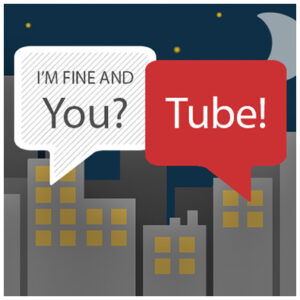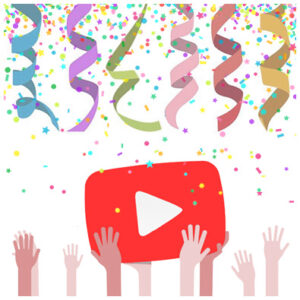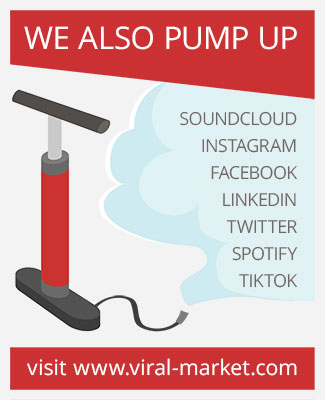A Necessary Premise
First, let me clarify: the Google Ads campaign discussed in this article was not set up by me personally, but by a young, newly hired team member. He’s eager and followed all the instructions carefully—but perhaps a little too quickly. That gave rise to an interesting situation, and it offered the perfect opportunity to raise some provocative questions in the Google Ads Community, based on a real-world case.
Of course, I know how to build effective YouTube campaigns via Google Ads. But I also know how many tricks and adjustments are needed to achieve even a minimum level of interaction. And to be honest, I’m not one of those who put Google Ads on a throne. Among the various services I offer at BestYoutubeViews.com, it’s probably the one I trust the least in terms of effectiveness and reliability.
The Myth of Google’s Unquestionable Reliability
In the collective imagination—especially among non-professionals—Google stands for quality and transparency. And yet, this very perception creates a huge distortion: people take it for granted that a view purchased through Google Ads is “organic,” reliable, and valuable for growing a YouTube channel. Spoiler alert: it’s not.

If you too are struggling with low-quality views or discrepancies in your campaigns, it might be due to improper settings or strategies. To better understand how to correctly set up your campaigns and minimize the risk of low-quality views, check out our detailed guide on how to effectively manage Google Ads campaigns for YouTube.
Fake Views? A Discussion on the Google Ads Community
I recently opened a discussion on the official Google Ads Community to share what I consider to be a very telling problem. You can read it here: Google Ads Views: Fake, Unreliable, and Damaging My Client Reputation
In short, the issue was this: the campaign, created to promote a music video, generated views that fluctuated up and down for days, never stabilizing. Something you don’t even see with the cheapest services offered by the shadiest social panels. On top of that—zero engagement. No likes. No comments. No subscribers.
Two expert members of the community replied. The first, in a calm tone, explained that the behavior of the view count is normal until the YouTube “settlement” period is complete. The second person raised a very interesting point: if you don’t change the default setting, the video will also be shown on smart TVs, where ads are often displayed on kids’ channels. On these devices, ads can’t be skipped, and there’s no opportunity for genuine interaction.
The Confirmation We Didn’t Expect: Google ADS Views Drop
One of the most striking responses I received in the Google Ads Community came from a seasoned expert who essentially normalized the problem I had been experiencing: views fluctuating up and down throughout the course of the campaign. According to James, a Diamond Product Expert in the community, such fluctuations are a regular part of how promoted YouTube ads work. Here’s a breakdown of his response:
“Promoted views will go up and down until settlement happens. This has always been my experience over the many years. That is how promoted YouTube ads work. View count takes a lot of time to process and settle… and so every day the ads are running there will be constant flux.”
Is This Really Acceptable?
James further stated that the view count in YouTube ads is something that takes time to “settle,” implying that it’s a temporary issue that should be accepted by advertisers. This brings us to a crucial question: Should we, as advertisers, just accept this?
James goes on to suggest that if he didn’t believe in Google Ads, he would stop using it. This brings up another layer of complexity—if this issue is accepted as “normal,” does that mean that Google Ads is simply asking users to tolerate an unreliable system, particularly when we are paying for something that is supposed to drive stable, quantifiable results?
A Fluctuating System: A Red Flag for Advertisers
This response raises significant concerns. While fluctuations may be a known issue for some, they still leave room for major questions about the stability and transparency of the system. When you invest in an advertising platform like Google Ads, especially when your reputation is at stake, you expect reliability. Having a view count that shifts unpredictably can give a false sense of success, making it difficult to measure campaign effectiveness in a meaningful way.
If these fluctuations are the norm, it means that the system might not be as stable or reliable as it is advertised to be. It also places advertisers in a difficult position, forcing them to question whether their budget is being spent effectively or if they are simply part of a larger, opaque process with too many unknowns.
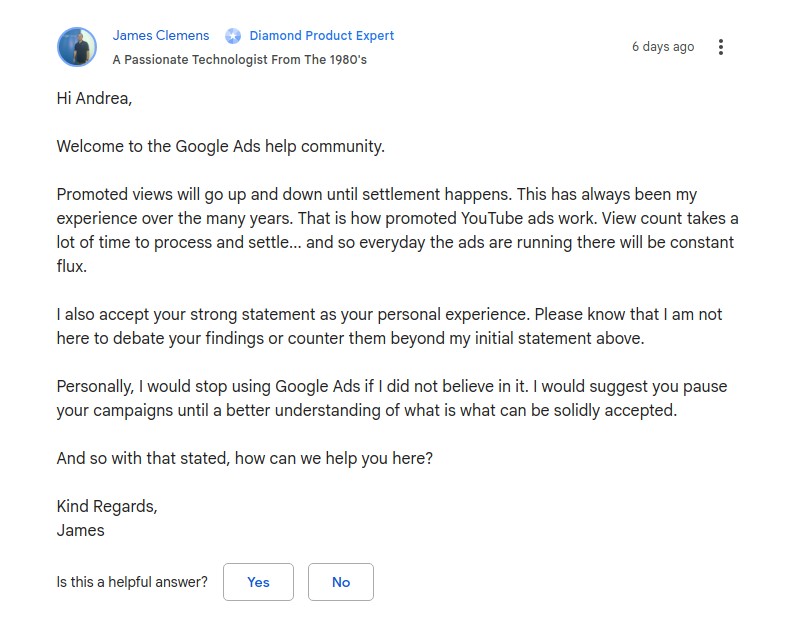
Another Confirmation: “Video targeting is incredibly poor”
Right during the discussion in the community, one of the two experts who responded to me – Rob, a Diamond Product Expert – openly admitted the following:
“Video targeting is incredibly poor. And it gets worse when you bid very low, it is an auction after all and the lowest bids get the worst placements. Kids channels get high view rates, often 50%, because babies can’t skip ads. They also of course convert terribly.”
This kind of statement, coming from an authoritative member of the community, is very significant. Not only does it validate the doubts I raised in my question, but it also highlights a systemic issue: if targeting is so weak, and if the system allows ads to end up on kids’ channels despite an 18+ targeting, then it’s not an error on the user’s part, but a structural limitation of the platform.
As if that weren’t enough, the same expert added:
“Google doesn’t set whether it is a kids channel or not, the channel owner does.”
In other words: if the definition of a “kids channel” is left to the self-declaration of the creator, and if the algorithm relies on this self-declaration to decide who to show ads to, then the demographic filter is highly unreliable. This strengthens my initial position: Google should better clarify these limitations or remove targeting options that it cannot properly support.
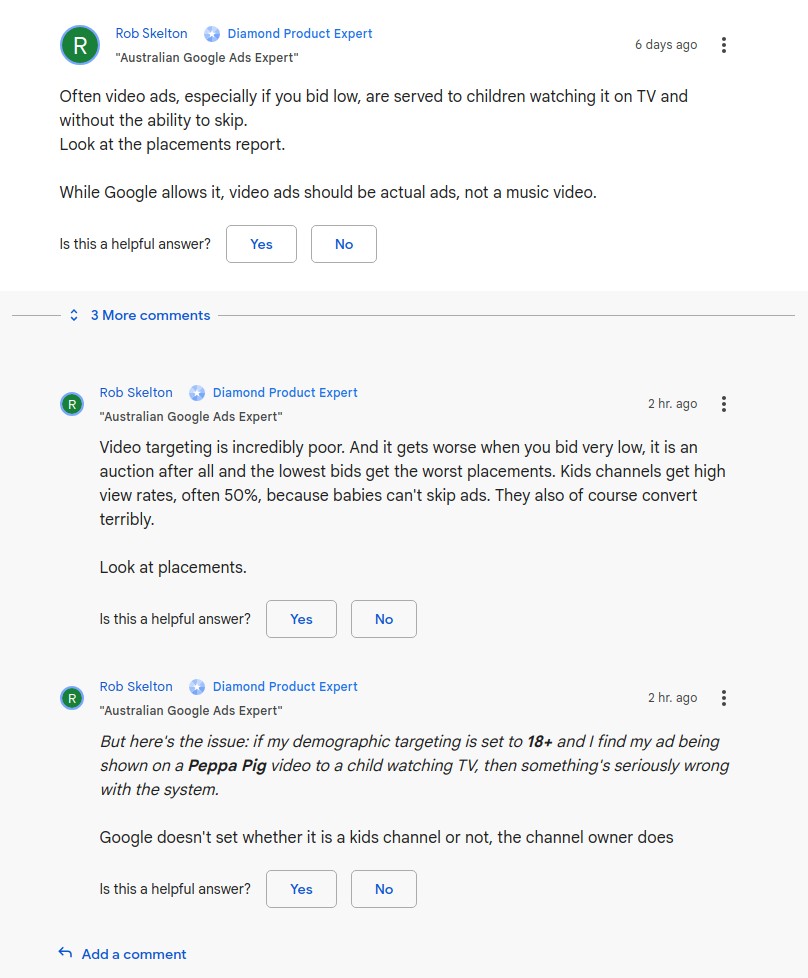
The Paradox of Demographic Targeting
In our case, the campaign was set to target viewers aged 18 and older. But if the ad is shown to a child anyway, there’s a serious problem.
The second expert responded that Google doesn’t know the actual age of the viewer—only the age of the account holder (which, in the case of children, is often a parent). This creates a serious distortion in how ads are distributed. At this point, Google should be transparent and clearly state that demographic filters are merely suggestions—not guarantees. Even better: disable them entirely to avoid setting false expectations.
The Confusion of Geotargeting: When “Include” Isn’t Enough
Another unclear aspect of the Google Ads system concerns geotargeting. In theory, selecting a single target country should be enough to restrict your ad’s visibility to that specific area. Yet, in practice, it’s not uncommon to see views coming from countries that were never selected, often with poor engagement and low retention.
A typical case? If you target only the United States, many experienced advertisers still recommend explicitly excluding countries like India or Bangladesh. At first glance, this seems redundant or even illogical: if you already stated that traffic should come only from the U.S., why would you need to add further exclusions?
The truth, as odd as it sounds, is that the system doesn’t always strictly enforce implicit exclusions. Some attribute this to bugs; others to poorly documented internal mechanisms. The end result is that to get reliable outcomes, you need to know and apply dozens of “unofficial” tweaks, passed around more like insider hacks than logical settings.
Topic Targeting: A Double-Edged Sword
Topic targeting in Google Ads allows you to target ads on web pages, apps, and videos related to specific subjects such as music, sports, or technology (support.google.com). While this option might seem advantageous for reaching a broad, relevant audience, in practice, it presents several limitations that can compromise campaign effectiveness.
1. Topic Selection: An Arbitrary Choice
The available topics in Google Ads are predefined and don’t always align with the specific needs of the advertiser. For instance, selecting a broad topic like “music” could encompass everything from classical music to electronic music, without clear differentiation between genres. This approach can lead to imprecise targeting, with ads being shown on pages that are not truly relevant to the product or service being offered.
2. Lack of Control Over Specific Pages
Unlike keyword targeting or specific placements, topic targeting does not allow you to select or exclude individual pages. This means ads may appear on sites that cover related but not directly relevant topics, reducing the quality of the traffic and increasing the risk of unqualified clicks.
3. Negative Experiences from Advertisers
Numerous industry professionals have reported issues with using topic targeting. For example, some users have noticed that despite selecting specific topics, their ads were shown on pages discussing unrelated subjects, indicating a lack of precision in Google Ads’ targeting system (outsourcesem.com).
Numerical Discrepancies Between Google Ads and YouTube Statistics
Among all the issues discussed above, one of the most frustrating and revealing is the inconsistency between the data reported by Google Ads and the actual view count shown on YouTube itself.
This is not just an occasional glitch or an isolated bug—it’s a recurring pattern that has been widely reported and discussed among advertisers and digital marketers.
Theoretically, views paid for through Google Ads should match the views displayed on the YouTube video’s public counter (after the standard delay due to YouTube’s view validation process). In reality, however, the numbers often don’t line up, and the discrepancies are sometimes dramatic.
While it’s true that YouTube takes some time to validate and display views, what many advertisers are observing goes beyond the usual settlement delay. In some cases, views shown in the Google Ads interface are double the number reported on YouTube—even after weeks have passed. This calls into question not just the timing of data synchronization, but the integrity of the reporting system itself.
Another example to mention, also found on the Google Ads Help Community, where a user shared the following:
“I put 220k display ads views on video but YouTube has not add 200k views update”
This isn’t a minor gap—it’s a 200,000-view difference. For any advertiser, this represents not just wasted budget, but also a breach of trust. The user’s tone reflects a growing sense of exasperation among many advertisers who feel they’re flying blind. And it doesn’t end there.
Another user, replying to the same thread, shared an even more sobering case:
“Me too. have a problem. Google Ads show 13990 but youtube show 6900, so bad.”
A short message, almost resigned, yet it perfectly encapsulates the frustration of countless advertisers investing hundreds or even thousands of dollars into a system that delivers ambiguous, unverifiable results.
These aren’t isolated cases. These are real-world experiences from advertisers who—just like many of us—trusted the Google Ads platform to deliver measurable, transparent outcomes. If Google Ads and YouTube can’t agree on something as fundamental as how many people actually saw your video, how can anyone be confident in the performance metrics they’re paying for?
In conclusion, this issue adds another layer of uncertainty to an already complex advertising platform. Until Google offers a transparent explanation or a fix, advertisers should approach campaign data not with blind trust—but with critical scrutiny and informed skepticism.
The Truth? Without Strong Know-How, You Get Nothing
Another point I raised: a Google Ads campaign set up without the right experience—without avoiding certain options and using the right workarounds—produces absolutely nothing. You could buy 200,000 views through Google Ads, but not receive them at all—or receive only a fraction, like 20,000 views instead of the promised 200,000, as seen in a previous example shared by a user on the Google Ads Help Community, where the discrepancy between the views reported by Google Ads and YouTube was substantial. And even if you do get the views, you might not receive a single like, comment, subscriber, or interaction.
Anyway, the problem goes beyond just the lack of interactions. It’s not just that you’re not getting the results you expect, it’s that you might not even get what you’ve paid for. Google Ads promises views, but those views might not materialize, or they might be far fewer than what was promised. This, in essence, could be seen as misleading advertising—something that, in many places, would be considered deceptive. In Italy, for example, this could be classified as “pubblicità ingannevole.” It’s a problem that goes beyond poor engagement; it’s about not receiving the very thing you paid for in the first place.
For example:
- Selecting “topics” to narrow the audience seems logical, but often leads to worse results.
- Using “in-feed” campaigns (that show up in search results or on the homepage) yields no time retention or engagement.
- Accepting automatic placements leads your ad to useless—or worse, harmful—channels.
- And even more concerning: the number of views you pay for doesn’t always match the number of views you actually receive. As highlighted in the previous section, you might see discrepancies between the promised views and what’s actually delivered, further questioning the reliability of the platform.
Conclusion: Yes, I Use Google Ads. But with Extreme Caution.
Yes, I do offer YouTube campaigns based on Google Ads on my website. But not because I blindly believe in them. I do it because many clients demand Google Ads, believing it’s a mark of quality. And with the experience I’ve gained, I know how to make even a flawed tool work.
But the truth is, the other services I offer—sourced from alternative networks and systems I personally test and monitor every day—are often more reliable, more predictable, and even more effective.
Links and References
- Google Ads Help Community – Official discussions and reports on issues related to non-authentic views on Google Ads.
- Reddit: “Are Google Display Ads Sending just like a LOT of Fake Bot Traffic?” (r/adops) – Real-life accounts from industry professionals about bot traffic and fake views in Google Display campaigns.
- Protect Your Google And YouTube Ads: Proven Strategies To Stop Fake Clicks (ClickPatrol) – Guidelines and tools to identify and prevent fraudulent clicks and views.
- How Bots Corrupted Advertising (Wired) – Article exploring the phenomenon of ad fraud caused by bot traffic.
Consultant in communication and marketing, I support professionals and businesses in enhancing their online presence through tailored strategies.
With extensive experience in digital marketing, I focus on designing targeted social media campaigns and managing video promotion projects.
I conduct ongoing research on social networks, especially YouTube, analyzing its algorithms, user behavior, and content dynamics to inform effective practices.













